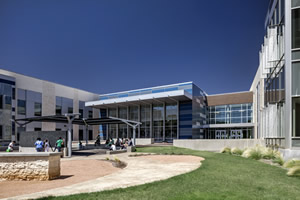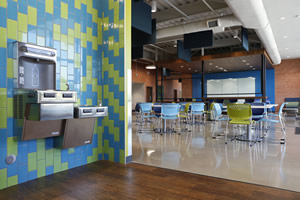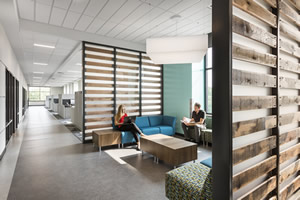Teacher WELLness: Could it be the key to better student outcomes?
- By Angie Stutsman
- 05/01/19
While schools have been very good at prioritizing student performance and engagement, they have been, generally speaking, less focused on providing spaces that support the well-being of those responsible for facilitating those outcomes. For teachers, largely unsupportive work environments intensify the pressures of the job and exacerbate common pain points including not having enough resources and the psychological demands of around the clock responsibilities. The multiplied pressures of chronic underfunding, mounting stress from education reforms, and nationwide staffing shortages are forcing teachers out of schools and taking their toll on education.
 In 2017, the Learning Policy Institute, reported the most common reason for non-retiring teachers (55 percent) to leave the profession was dissatisfaction at work. While burnout might be pushing many to call it quits, 28 percent of active teachers miss more than 10 days of school per year according to the Department of Education. The grim outlook on the health, wellbeing, and satisfaction of teachers has also been correlated to student performance. Last year, the University of Missouri studied student behavior and math and reading scores against the self-reported stress levels of their teachers—finding those students with low-stress teachers performed best in both areas. Conversely, those with teachers reporting higher stress levels showed a drop in their behavioral performance and math scores.
In 2017, the Learning Policy Institute, reported the most common reason for non-retiring teachers (55 percent) to leave the profession was dissatisfaction at work. While burnout might be pushing many to call it quits, 28 percent of active teachers miss more than 10 days of school per year according to the Department of Education. The grim outlook on the health, wellbeing, and satisfaction of teachers has also been correlated to student performance. Last year, the University of Missouri studied student behavior and math and reading scores against the self-reported stress levels of their teachers—finding those students with low-stress teachers performed best in both areas. Conversely, those with teachers reporting higher stress levels showed a drop in their behavioral performance and math scores.
As districts begin to recognize teachers as one of the largest drivers of quality education and student experience, new models of building design provide powerful opportunities to consider the impact of the built environment on the people and culture inside, improve teacher wellbeing, and ultimately, promote better student outcomes. The WELL Building Standard, a new performance-based system for measuring, certifying, and monitoring 10 core principles from air and nourishment to water and lighting offers a roadmap to healthier, more human buildings. Evolving strides in more sustainable, human-centric design, the WELL Building Standard has gained popularity in Corporate America and is being adapted for the school setting to uncover common design pitfalls, provide realistic, practical solutions, and activate the campus as a tool to improve wellbeing, drive satisfaction and productivity, and support the top talent in education.
For schools without extensive design plans or budgets, small changes inspired by these WELL principles can add up to big changes in addressing some of the most common pain points for teachers and creating a healthier place for students to learn, teachers to work, and the school community to grow.
AIR AND TEMPERATURE
COMMON PAIN POINT: Temperature
Attention to air quality and temperature in built environments can mean more than added comfort. A 2015 study correlated the performance of nine cognitive functions to higher rates of ventilation that removed volatile organic compounds (VOCs) and CO2 from the air. Practical interventions can help. For instance, many schools have plans for yearly maintence, but a plan to check and clean the air filtration system every six months or quarterly combined with CO2 sensors can help better monitor, prevent, and respond to potential air quality issues. Evaluating the presence of chemicals in materials such as paint or floor wax or in in common maintence protocols such as pesticide management and cleaning identifies opportunities to reduce VOCs with nontoxic, minimally invasive, and healthier alternatives.
Thermal comfort is a common pain point on many campuses. The wrong temperature can be distressful and frustrating. Operable walls and doors can also welcome circulation of fresh air while adding a layer of temperature control. Checking and balancing HVAC levels can help optimize heating and cooling to create comfortable spaces for teachers and students—minimizing distractions and reducing unnecessary agitations.
LIGHT
COMMON PAIN POINT: Harsh, industrial lighting and limited natural light
Harsh lighting and a lack of natural light exacerbates the strain on teachers who are already stretched thin—making the problem of sleep deficits and slowed productivity worse. Harsh fluorescent lighting and lensed fixtures are rarely tuned to the distinctions our body needs to signal alertness in the morning or prepares for a better sleep in the latter part of the day. Time off the clock, particularly time spent asleep, directly impacts “on the clock” performance in four key areas: attention and concentration, reaction time, decision-making, and memory. Missing sleep also cuts into emotional and organizational performance, making it difficult to stay focused, respond to unexpected challenges, or manage frustrating social situations.
Though natural lighting is ideal and should be prioritized whenever possible, it’s not always possible in every classroom or campus configuration. Smart lighting approaches and small changes, however, can help teachers sleep, work, and feel better throughout the day. Consider checking light levels in classrooms and maintaining an average of 175 lux (16 f.c.) at 30 inches above the finished floor. Lighting should also be customizable to match the task at hand. Shades and layered lighting including individual task lights and dimmable options provide the power of choice to create the best environment to support each teacher’s individual pedagogy.
WATER AND NOURISHMENT
COMMON PAIN POINT: Not enough time to eat
 Placing a filtered water station in the teacher’s work room or at strategic points throughout the campus and trading traditional vending machine snacks for fresh fruits and vegetables keeps healthy options front of mind and easily accessible. Setting a culture of health and well-being, encourages teachers to stay hydrated and make better nutritional decisions throughout their day—swapping coffee for water, for instance—improving their cognitive functioning and helping maintain the energy they need for the day.
Placing a filtered water station in the teacher’s work room or at strategic points throughout the campus and trading traditional vending machine snacks for fresh fruits and vegetables keeps healthy options front of mind and easily accessible. Setting a culture of health and well-being, encourages teachers to stay hydrated and make better nutritional decisions throughout their day—swapping coffee for water, for instance—improving their cognitive functioning and helping maintain the energy they need for the day.
Dedicated and convenient places to sit and eat encourages socialization and connections with other teachers throughout the campus. In addition to creating an opportunity for learning and mentorship, these spaces for social interaction offer a balanced way to manage work-related stress, increase motivation and engagement, and improve retention. Smaller destinations such as coffee bars or micro-kitchens with refrigerators, microwaves and utensils throughout the campus can also create intentional and casual gathering opportunities while bringing convenient nodes to quickly refuel closer to other classrooms.
FITNESS
COMMON PAIN POINT: Ergonomics
Sit to stand desks, wellness mats, and ergonomic chairs can help quickly address common teacher pain points in classrooms. Injecting movement and activity into the classroom, improved workstations afford teachers variety in their work posture while seamlessly adding a healthier option to where they spend a majority of their day. Large circulation paths typical of many schools can be complemented with a walking map or distance markers for teachers and the onsite fitness programming can activate the gym afterschool with stationary bikes or a yoga class—encouraging teachers to incorporate small steps throughout their day and inviting staff to take advantage of convenient options to prioritize and improve their physical health.
MINDFULNESS
COMMON PAIN POINT: Always on
 For teachers, the school day means operating around the clock on high alert—managing overcrowded classrooms, facilitating learning, monitoring social activities, and being available to manage a variety of matters from office hours to student safety. While school design typically considers spaces for student mental health, refuge, and socialization, it often overlooks these spaces for teachers as opportunities to incorporate these same elements. Mindful design begins with considering the needs of the school staff. Occupancy surveys to gather feedback of the building from teachers not only signals their value but also provides insight on how best to steward and direct resources. Residentially inspired finishes in work areas including artwork, plants, wood, and inviting textiles replicate the sensory effect of a warmer, more familiar space while more involved programming such as stress and addiction treatment or “me moments” with respite pods, aromatherapy, or white noise can meet the more comprehensive wellness needs of teachers.
For teachers, the school day means operating around the clock on high alert—managing overcrowded classrooms, facilitating learning, monitoring social activities, and being available to manage a variety of matters from office hours to student safety. While school design typically considers spaces for student mental health, refuge, and socialization, it often overlooks these spaces for teachers as opportunities to incorporate these same elements. Mindful design begins with considering the needs of the school staff. Occupancy surveys to gather feedback of the building from teachers not only signals their value but also provides insight on how best to steward and direct resources. Residentially inspired finishes in work areas including artwork, plants, wood, and inviting textiles replicate the sensory effect of a warmer, more familiar space while more involved programming such as stress and addiction treatment or “me moments” with respite pods, aromatherapy, or white noise can meet the more comprehensive wellness needs of teachers.
Traditional workplaces have already tapped into the potential of the work environment to meet the needs of the employees, attract future talent, and drive results. Though few corporate trends could be literally and exactly translated for the school setting, education has a powerful opportunity to adapt these key drivers to support the physical and psychological demands on teachers and create a healthy campus community to best support the success of its students.